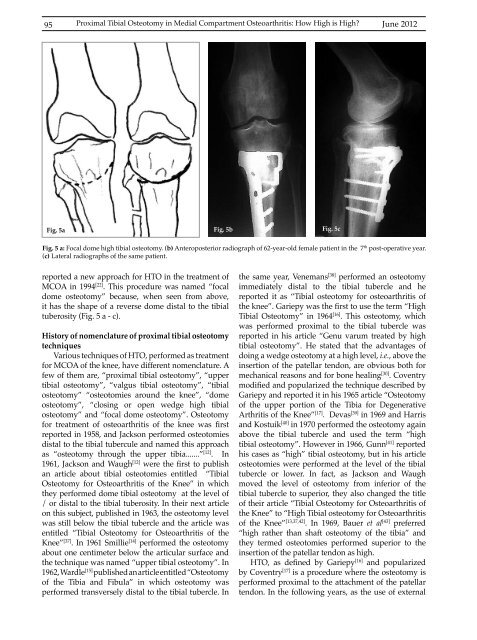Vol 44 # 2 June 2012 - Kma.org.kw
Vol 44 # 2 June 2012 - Kma.org.kw
Vol 44 # 2 June 2012 - Kma.org.kw
You also want an ePaper? Increase the reach of your titles
YUMPU automatically turns print PDFs into web optimized ePapers that Google loves.
95<br />
Proximal Tibial Osteotomy in Medial Compartment Osteoarthritis: How High is High?<br />
<strong>June</strong> <strong>2012</strong><br />
Fig. 5a Fig. 5b Fig. 5c<br />
Fig. 5 a: Focal dome high tibial osteotomy. (b) Anteroposterior radiograph of 62-year-old female patient in the 7 th post-operative year.<br />
(c) Lateral radiographs of the same patient.<br />
reported a new approach for HTO in the treatment of<br />
MCOA in 1994 [22] . This procedure was named “focal<br />
dome osteotomy” because, when seen from above,<br />
it has the shape of a reverse dome distal to the tibial<br />
tuberosity (Fig. 5 a - c).<br />
History of nomenclature of proximal tibial osteotomy<br />
techniques<br />
Various techniques of HTO, performed as treatment<br />
for MCOA of the knee, have different nomenclature. A<br />
few of them are, “proximal tibial osteotomy”, “upper<br />
tibial osteotomy”, “valgus tibial osteotomy”, “tibial<br />
osteotomy” “osteotomies around the knee”, “dome<br />
osteotomy”, “closing or open wedge high tibial<br />
osteotomy” and “focal dome osteotomy”. Osteotomy<br />
for treatment of osteoarthritis of the knee was first<br />
reported in 1958, and Jackson performed osteotomies<br />
distal to the tibial tubercule and named this approach<br />
as “osteotomy through the upper tibia.......” [12] . In<br />
1961, Jackson and Waugh [12] were the first to publish<br />
an article about tibial osteotomies entitled “Tibial<br />
Osteotomy for Osteoarthritis of the Knee” in which<br />
they performed dome tibial osteotomy at the level of<br />
/ or distal to the tibial tuberosity. In their next article<br />
on this subject, published in 1963, the osteotomy level<br />
was still below the tibial tubercle and the article was<br />
entitled “Tibial Osteotomy for Osteoarthritis of the<br />
Knee” [37] . In 1961 Smillie [14] performed the osteotomy<br />
about one centimeter below the articular surface and<br />
the technique was named “upper tibial osteotomy”. In<br />
1962, Wardle [15] published an article entitled “Osteotomy<br />
of the Tibia and Fibula” in which osteotomy was<br />
performed transversely distal to the tibial tubercle. In<br />
the same year, Venemans [38] performed an osteotomy<br />
immediately distal to the tibial tubercle and he<br />
reported it as “Tibial osteotomy for osteoarthritis of<br />
the knee”. Gariepy was the first to use the term “High<br />
Tibial Osteotomy” in 1964 [16] . This osteotomy, which<br />
was performed proximal to the tibial tubercle was<br />
reported in his article “Genu varum treated by high<br />
tibial osteotomy”. He stated that the advantages of<br />
doing a wedge osteotomy at a high level, i.e., above the<br />
insertion of the patellar tendon, are obvious both for<br />
mechanical reasons and for bone healing [30] . Coventry<br />
modified and popularized the technique described by<br />
Gariepy and reported it in his 1965 article “Osteotomy<br />
of the upper portion of the Tibia for Degenerative<br />
Arthritis of the Knee” [17] . Devas [39] in 1969 and Harris<br />
and Kostuik [40] in 1970 performed the osteotomy again<br />
above the tibial tubercle and used the term “high<br />
tibial osteotomy”. However in 1966, Gunn [41] reported<br />
his cases as “high” tibial osteotomy, but in his article<br />
osteotomies were performed at the level of the tibial<br />
tubercle or lower. In fact, as Jackson and Waugh<br />
moved the level of osteotomy from inferior of the<br />
tibial tubercle to superior, they also changed the title<br />
of their article “Tibial Osteotomy for Osteoarthritis of<br />
the Knee” to “High Tibial osteotomy for Osteoarthritis<br />
of the Knee” [13,37,42] . In 1969, Bauer et al [43] preferred<br />
“high rather than shaft osteotomy of the tibia” and<br />
they termed osteotomies performed superior to the<br />
insertion of the patellar tendon as high.<br />
HTO, as defined by Gariepy [16] and popularized<br />
by Coventry [17] is a procedure where the osteotomy is<br />
performed proximal to the attachment of the patellar<br />
tendon. In the following years, as the use of external
















